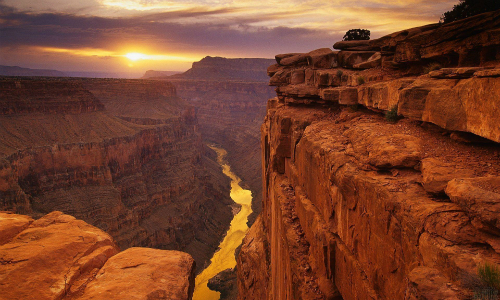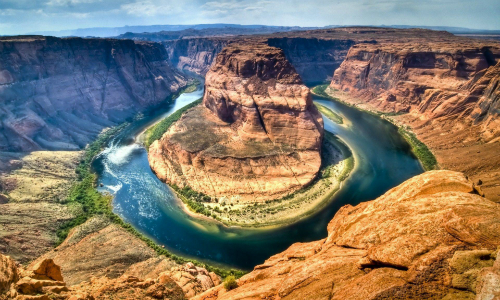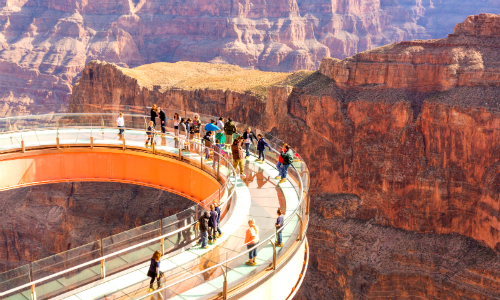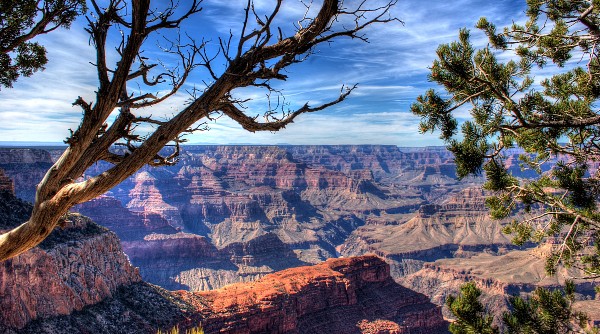One of the best road trips and destination ideas you’ll find in the USA is the Grand Canyon.
The Grand Canyon is an awe-inspiring place that offers much more than just a look at the mile-deep, ten-mile-wide gorge of multi-colored, multi-layered rock. It is a region of historical landmarks, native culture, an abundance of wildlife, and sightseeing opportunities that go far beyond a lookout point. It offers much in the way of excursions, activities, shopping, and dining.
Unfortunately; however, most travelers think of the canyon as something to look at for a few minutes, snap a few photos, and then be on their way. So it doesn’t dawn on them to do any prior research to help make the most of the time spent there. As such, this is a destination that many travelers tend to squeeze between other destinations, such as a day trip worked into a Las Vegas vacation, or a brief stopover on the way to somewhere else. These scenarios give limited time and opportunity to truly experience the canyon and it leaves travelers feeling as though they missed out when they discover the things they could have seen and done. And that’s exactly why vacationing in the area is far more conducive to actually seeing and experiencing the Grand Canyon.
The first thing to do is to ascertain which part (or parts) of the canyon you most desire to see. Most tourists are unaware of the different entry points and views. Tourists can visit the North, South, East, or West rim, all of which offer different vistas, unique landmarks, and varying excursion options.
The North Rim
 The North Rim is the most difficult to access and is closed throughout the winter months so this is the least popular for tourists. If you’re visiting the canyon for the first time, this probably is not your best option. However, travelers that make it there during the May 15th to Oct 15th season are assured of gorgeous views along with access to the Grand Canyon Lodge, which was built in 1927. The area offers scenic drives, mule rides, ranger programs, hiking trails, helicopter and ATV tours, and several campgrounds for visitors desiring a woodsy experience.
The North Rim is the most difficult to access and is closed throughout the winter months so this is the least popular for tourists. If you’re visiting the canyon for the first time, this probably is not your best option. However, travelers that make it there during the May 15th to Oct 15th season are assured of gorgeous views along with access to the Grand Canyon Lodge, which was built in 1927. The area offers scenic drives, mule rides, ranger programs, hiking trails, helicopter and ATV tours, and several campgrounds for visitors desiring a woodsy experience.
Tourists can check out the Yavapai Geology Museum located at the former Yavapai Observation Station. Exhibits in the museum, including a topographic model, depict the deposition of the rock layers and the natural carving of the Grand Canyon due to the rise of the Colorado River.
For more naturally formed wonders, visitors can take a tour of Monument Valley via an excursion company, or by undertaking the almost 4-hour drive to gaze upon Navajo land rich with heritage and stunning rock formations.
The South Rim
 Ironically, the South Rim is located in the Northwest corner of Arizona and is proven to be the most popular tourist spot. It comes with reasonable drive times of 3.5 hours from Phoenix and approximately 4.5 from Las Vegas with the option of seeing Hoover Dam along the way. This region is accessible by car, plane or train, and offers the iconic wide-sweeping lookout with walking trails that branch off in either direction. Access is granted via Grand Canyon National Park with vehicle permits costing $30 no matter how many people are in the car.
Ironically, the South Rim is located in the Northwest corner of Arizona and is proven to be the most popular tourist spot. It comes with reasonable drive times of 3.5 hours from Phoenix and approximately 4.5 from Las Vegas with the option of seeing Hoover Dam along the way. This region is accessible by car, plane or train, and offers the iconic wide-sweeping lookout with walking trails that branch off in either direction. Access is granted via Grand Canyon National Park with vehicle permits costing $30 no matter how many people are in the car.
The South Rim is open 24 hours a day, 365 days a year including holidays, however, the Visitor Center and other relative facilities alter their hours between peak and off-peak seasons. A multitude of excursions and activities exist in this area, including scenic drives, bus tours, convenient shuttle buses, walking, and hiking tours, plane and helicopter tours, and beloved mule rides. As well, there are white water rafting experiences and pontoon boat adventures on the Colorado River. A quick Google search will yield an abundance of tour companies that provide such excursions for varying time lengths and prices.
Some lodging and dining options can be found inside the park, or at the entrance called Grand Canyon Village. For retail needs, the South Rim features the very convenient Market Plaza, located directly next to Yavapai Lodge. Here you can find a bank and a post office, as well as a convenient deli, a variety of groceries and souvenirs, Native American handcrafts, and much in the way of hiking and camping gear.
For travelers wishing to know more about the area, head to The National Geographic Visitor’s Center to attend the IMAX Theater and see the stunning film Grand Canyon: The Hidden Secrets. Viewers get a bird’s eye view of what’s it like to soar above the canyon cliffs, raft down the rapids of the Colorado River, and descend to the surreptitious depths of the gorge.
As for historic landmarks, the South Rim has plenty, including El Tovar, the 1905 premier hotel that was designed to resemble a Swiss Villa and has since played host to several celebrities. Also to be found are the 70-foot Desert View Watchtower, which was built in 1932; the Lookout Tower, which was built in 1914 and is precariously perched on the edge of the rim; and the 1905 Native American adobe-style Hopi House, which now houses a gift shop.
For adventurers interested in the wildlife of the region (but are unprepared to track it through the dense forest) there’s Bearizona Wildlife Park, with 160 acres to be explored, approximately a 58-minute drive from the South Rim. The attraction is just off Historic Route 66 and is easy to find. Here, tourists are able to take a scenic drive through the parkland to view indigenous animals roaming free in their natural habitat of pine forests and canyon formations. This includes longhorn sheep, burros, black bears, bison, bobcats, and wolves. Additionally, the park features a walk-through trail of exhibits as well as live shows featuring birds of prey native to the region.
The East Rim
 The East Rim is gaining in popularity lately as it presents somewhat of a different view with a lot more emphasis on the Colorado River. The Little Colorado River Tribal Park in Navajo Nation is located on the East Rim, as are the spectacular Navajo Bridge, and The Rainbow Bridge, the world’s largest known natural bridge considered sacred by Native American Tribes. Accessing some of this area requires a permit from the Navajo Tribe, so be sure to inquire before venturing out on a hike.
The East Rim is gaining in popularity lately as it presents somewhat of a different view with a lot more emphasis on the Colorado River. The Little Colorado River Tribal Park in Navajo Nation is located on the East Rim, as are the spectacular Navajo Bridge, and The Rainbow Bridge, the world’s largest known natural bridge considered sacred by Native American Tribes. Accessing some of this area requires a permit from the Navajo Tribe, so be sure to inquire before venturing out on a hike.
Tourists looking for more Native American culture can venture to Tuba City, approximately a 1.5 drive from the East Rim, to partake in the Hopi Native Reservation Tour. Or, head to Window Rock, Arizona, a 3.5-hour drive from the East Rim, if you wish to undertake the Navajo Nation Tour.
The West Rim
 This rim is most widely known for The Skywalk at Eagle Point, a horseshoe-shaped, transparent glass bridge that extends 70 feet over the rim of the canyon and allows visitors unique views of the gorge directly below. Built by the Hualapai Tribe, the Skywalk attraction features an authentic Native American Village onsite that tourists can explore, as well as a gift shop of unique souvenirs and handicrafts. The Sa’ Nyu Wa dining room serves Southwest and Asian fusion cuisine for visitors wishing to stay for lunch or dinner, and live entertainment in the form of Native American dances takes place daily in the amphitheater at 1 p.m. and 5 p.m.
This rim is most widely known for The Skywalk at Eagle Point, a horseshoe-shaped, transparent glass bridge that extends 70 feet over the rim of the canyon and allows visitors unique views of the gorge directly below. Built by the Hualapai Tribe, the Skywalk attraction features an authentic Native American Village onsite that tourists can explore, as well as a gift shop of unique souvenirs and handicrafts. The Sa’ Nyu Wa dining room serves Southwest and Asian fusion cuisine for visitors wishing to stay for lunch or dinner, and live entertainment in the form of Native American dances takes place daily in the amphitheater at 1 p.m. and 5 p.m.


